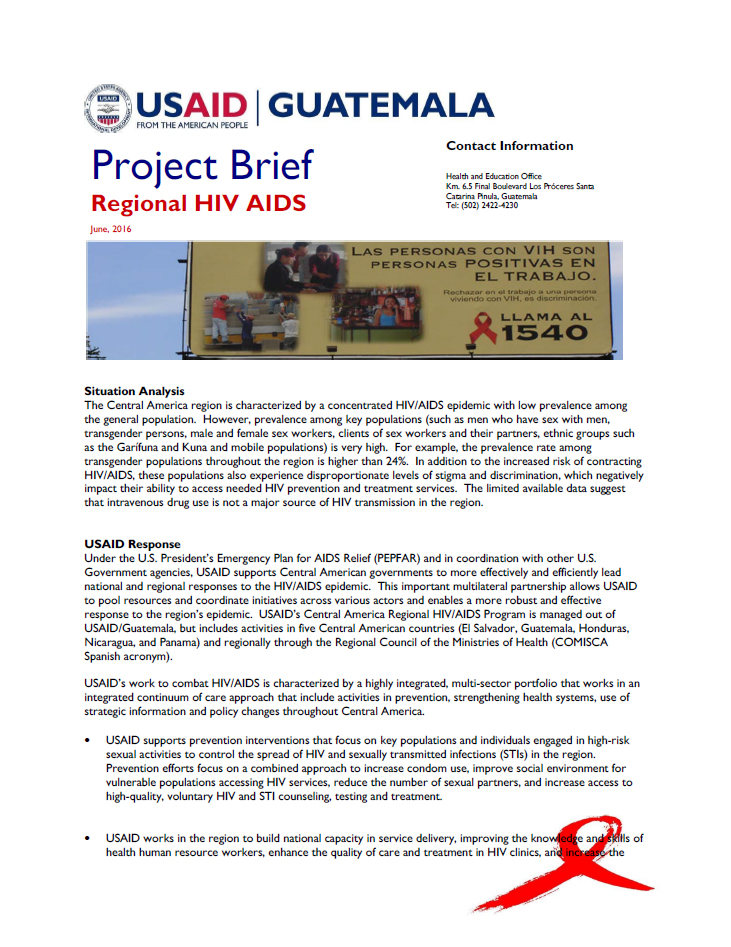Situation Analysis
Sector Brief - Regional HIV AIDS ![]() (pdf - 130k)
(pdf - 130k)
Central America is characterized by a concentrated HIV/AIDS epidemic with low prevalence among the general population. However, prevalence among key populations (such as men who have sex with men, transgender persons, male and female sex workers, clients of sex workers and their partners, ethnic groups such as the Garífuna and Kuna, and mobile populations) is very high. For example, the prevalence rate among transgender populations throughout the region is higher than 24%.
In addition to the increased risk of contracting HIV/AIDS, these populations also experience disproportionate levels of stigma and discrimination, which negatively impact their ability to access HIV prevention and treatment services. Limited data available suggests that intravenous drug use is not a major source of HIV transmission in the region.
USAID’s Response
Under the U.S. President’s Emergency Plan for AIDS Relief (PEPFAR), USAID, along with other United States Government agencies, supports Central American governments to more effectively and efficiently lead national and regional responses to the HIV/AIDS epidemic. This important multilateral partnership allows USAID to pool resources and coordinate initiatives across various actors and enables a more robust and effective response to the region’s epidemic. USAID’s Central America Regional HIV/AIDS Program is managed out of USAID/Guatemala, but includes activities in all seven Central American countries (Belize, Costa Rica, El Salvador, Guatemala, Honduras, Nicaragua, and Panama).
USAID’s work to combat HIV/AIDS is characterized by a highly integrated, multi-sector portfolio that works in prevention, strengthening health systems, use of strategic information, and policy change throughout Central America.
- USAID’s prevention interventions focus on key populations and individuals engaged in high-risk sexual activities to control the spread of HIV and sexually transmitted infections (STIs). Prevention efforts focus on increasing condom use, reducing the number of sexual partners, and increasing access to high-quality, voluntary HIV and STI counseling, testing, and treatment.
- USAID helps build national capacity in service delivery, health workforce, human resources information systems, and timely and adequate provision of essential medical products.
- Given the importance of reliable information for tracking and monitoring HIV/AIDS rates, USAID supports national governments in improving data collection, data analysis, and use of strategic information. USAID also strengthens the capacity of human resources in conducting monitoring and evaluation.
- In the area of policy change, USAID’s activities focus on the implementation of country strategic plans and monitoring and evaluation, strengthening civil society organizations, implementing policy advocacy agendas, and improving implementation of the Global Fund projects. USAID also engages the private sector in the HIV response through the development of HIV workplace policies.
Principal Results and Accomplishments
USAID’s efforts have resulted in:
- Positive impacts on behavior change – More than 65,000 members of key populations were reached with combination HIV prevention services in 2013, an increase of 15% from the previous year. Safe sexual behaviors such as condom use and HIV testing are adopted at a significantly higher rate by people exposed to USAID’s HIV combination prevention programs.
- Improved health services – USAID’s activities have improved the quality of services for people with HIV in 90 hospitals in six countries. USAID’s activities have also trained more than 5,000 health personnel in HIV-related topics such as: quality of care, stigma and discrimination, monitoring and evaluation, biosecurity, and performance improvement.
- Strengthened health systems – Ministry of Health national supply chains have been strengthened to improve HIV programs in Guatemala, El Salvador, and Panama. USAID also supported improved quality of HIV strategic information used for decision making.
- Engagement with the private sector – USAID held an inaugural regional forum for the private sector in Central America entitled “Business Leadership and HIV,” attended by more than 130 entrepreneurs across the region. USAID also facilitated the development of HIV workplace policies that protect more than 350,000 people in more than 150 businesses and organizations.
Project Overview
|
Project Name |
Implementing Partner |
Duration |
|
Comprehensive Care in Central America (CAPACITY Plus) |
IntraHealth |
April 26, 2011 – September 30, 2016 |
|
HIV/AIDS Combination Prevention Program for Central America |
Population Services International (PSI) |
September 30, 2010 – September 29, 2015 |
|
Program for Strengthening the Central American Response to HIV/AIDS (PASCA) |
Management Sciences for Health (MSH) |
March 27, 2014 - September 30, 2016 |
|
Supply Chain Management |
Partnership for Supply Chain Management |
June 1, 2009 – September 30, 2015 |









Comment
Make a general inquiry or suggest an improvement.